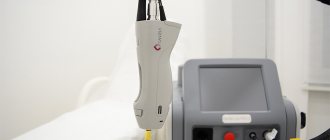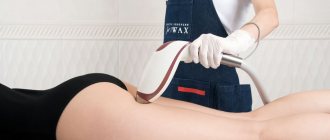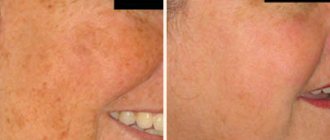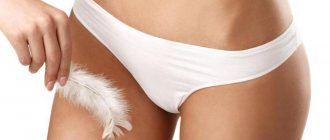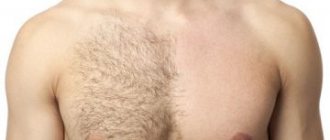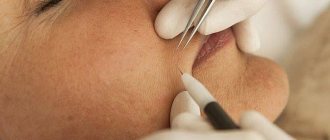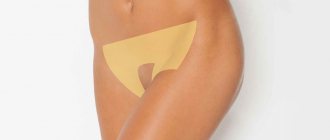From this article you will learn:
- What is laser hair removal
- What types of lasers are used in epilation to remove hair?
- Laser hair removal on the face: stages and nuances of the procedure
- Basics and subtleties of laser hair removal on legs
- Frequently asked questions about laser hair removal
Laser hair removal is a modern method in cosmetology. The use of laser is effective because it contributes to the complete destruction of hair follicles.
Thanks to this procedure, many women received an excellent opportunity to say goodbye to hair in one or another part of the body forever, moreover, the whole process goes quite quickly and, importantly, painlessly. We will tell you more about laser hair removal below.
The essence of the technique
Laser hair removal is a medical procedure. The principle of operation is the effect of laser radiation (light of a certain length) on the melanin pigment present in the hair. It gives a characteristic shade to the hair.
The melanin pigment is presented in two fractions:
- Pheomelanin.
- Eumelanin.
Hair color is determined by the ratio of these fractions. If there is more eumelanin, the hair will be dark and vice versa.
Pheomelanin reflects light rather than absorbing it, so for people with red and blond hair, where it is found most, laser hair removal is not always possible.
Eumeline absorbs light and triggers the breakdown of chemical compounds when exposed to high temperatures. The principle is as follows: first, the hair shaft is heated, then the heat moves to the root and follicle. The thermal reaction occurs quickly, causing blockage of blood vessels and cessation of nutrition of the hair, as a result of which it gradually dies and falls out.
Operating principle
The laser procedure is classified as a cosmetic procedure and is performed using various laser devices.
The mechanism is based on the interaction of pulsed light with hair pigment. The shaft and follicle of each hair contains a lot of melanin. This substance absorbs light waves in a specific range - from 700 to 800 nanometers.
The operating principle of laser hair removal is the rapid delivery of short pulses. This makes it possible to work selectively with hair melanin, heating only it without traumatizing surrounding tissues.
The pigment begins to absorb laser energy, which greatly heats the hair. The temperature is transmitted to the follicle. Under the influence of high temperatures, the germinal zone of the follicle, lymphatic and blood vessels are destroyed. Hair treated with the device dies, falls out, and then does not grow for 1-1.5 years.
The technique is relatively simple, but due to the use of expensive equipment, the procedure costs a lot. However, the method is often used to remove antennae, external signs of hirsutism.
Types of lasers, their differences
Several types of lasers are used in cosmetology practice. They differ mainly in the wavelength of the emitted light. The longer it is, the greater the depth of penetration and the higher the efficiency. There may also be differences in the radiation energy and the duration of the pulses themselves.
Lasers are presented in the following types:
- alexandrite;
- ruby;
- neodymium;
- diode
The differences between lasers can be clearly seen in the table below:
| Alexandrite laser | Diode | Ruby | Neodymium | |
| Wavelength | 725 nm | 800-900 nm | 694 nm | 1064 nm |
| Pulse duration | 0.25-300 ms | 5 to 400 ms | 3 ms | 0.25-300 ms |
| Pulse frequency | Up to 1.5 Hz | Up to 2 Hz | 1Hz (1 pulse per second) | |
| Power | 20-40 J/cm2 | Up to 100 J/cm2 | Up to 40 J/cm2 | Up to 300 J/cm2 |
| Can it be applied to light and red hair? | does not remove very light and gray hairs | Yes | No | Yes |
| Application on dark skin | No | Yes | No | Yes |
| Efficiency | +++ | ++++ | ++ | ++ |
| Possibility of getting burned | +++ | + | ++++ | + |
| Duration and number of sessions | +++ | ++ | ++++ | ++++ |
Ruby laser
It is one of the first to be used to get rid of unnecessary vegetation. Today it is outdated and practically not used.
Alexandrite laser
Alexandrite is most effective against dark hair on light, untanned skin. When using it, external cooling of the skin is required. If the parameters are set incorrectly, the risk of burns is high. During the session, patients often complain of pain.
Diode
For diode, the wavelength of radiation is in the region of greatest absorption by melanin, therefore it is recognized as the most effective. This laser can be used on all skin types and for any hair, even with low melanin content. Spider veins and subcutaneous vessels can also be removed with a diode laser.
Read also: Laser hair removal for men: smooth skin without pain and irritation
Neodymium laser
Ineffective for removing unwanted hair. It does not act on melanin, but on the vessels that nourish the hair. It is used primarily to eliminate vascular networks and scars. Not limited to skin types. Such devices cannot be found in beauty salons; they are available only in specialized clinics.
Laser parameters that affect the results[edit | edit code]
Several wavelengths of laser energy have been used for hair removal, from visible light to near-infrared radiation. Lasers are characterized by their wavelength, measured in nanometers (nm).
| Argon: 488 nm (turquoise/blue) or 514.5 nm (green) (no longer used for hair removal) |
| Ruby: 694.3 nm (deep red) (safe only for patients with very pale skin) |
| Alexandrite: 755 nm (closer to infrared) (safe and effective for all skin types, Fitzpatrick types I-VI) |
| Pulsed Diode: 810 nm (near infrared) (pale to medium skin types) |
| Nd:YAG : 1064 nm (near IR) (to treat darker skin types, although effective on all skin types) |
| Intense Pulsed Light (IPL is not a laser) 650nm wavelength light (used for hair removal on pale to medium skin types) |
Pulse Width (or Duration)
is one of the most important parameters. The length of the thermal impulses is directly related to the damage occurring in the follicle. When trying to destroy hair follicles, the main target is the germ cells that live on the surface of the hair. Light energy is absorbed by the melanin of the hair and heat is released. The heat then leads towards the germ or stem cells. A sufficiently high temperature is maintained for the required time, then the cells will be successfully destroyed. This is certainly important, since not only the temperature of the beam is important, but also the time that this beam is “stored” in the follicle, affecting the germ cells.[16] To achieve these conditions, the laser/IPL system must be capable of generating the required output power. The main reason why hair removal fails is because the equipment cannot create the right temperature in the right amount of time.
spot size
, or the width of the laser beam, directly affects the penetration depth of light energy due to scattering effects in the dermal layer. Larger beam diameters conduct deeper energy deposition and can therefore induce higher temperatures in deeper follicles. The laser beam has a diameter comparable to the tip of a finger (3-18 mm).
Fluence or energy density
- This is another important parameter. Fluence is measured in joules per square centimeter (J/cm). It is important to adjust this parameter so that the temperature inside the follicle is sufficient to destroy the hair stem cells.
Epidermal cooling
allows you to work at higher fluences and reduce pain and side effects, especially on dark skin. 3 types of epidermal cooling have been developed:
- Contact cooling: special tool with a cooling tip. In such instruments, laser radiation is directed through a sapphire window in contact with the skin. The sapphire window, which has a high thermal conductivity, is constantly cooled using a built-in thermoelectric converter or by pumping refrigerant. A nanotech sapphire window with contact cooling of the working laser emitter before, during, and after the procedure allows for painless hair removal. Sapphire windows are much more conductive than quartz. This type of cooling is the most effective method of maintaining epidermal protection as it provides continuous heat transfer to the surface of the skin.
- Cryogen spray: sprayed directly onto the skin immediately before and/or after the laser pulse
- Air cooling: directed flow of cold air at -34 degrees C.
In essence, an important output parameter in hair removal (and other skin conditions) is power density - a combination of energy, spot diameter and pulse duration. These three parameters determine what actually happens when a beam of light is absorbed by a chromophore, be it melatonin, hemoglobin, etc. the volume of tissue destroyed depends on exposure time and temperature.
Advantages and disadvantages
Like any other method, laser hair removal has its pros and cons. The benefits include:
- getting rid of unwanted vegetation for a long period of time (several years) and even forever;
- the possibility of infection is excluded and the risk of scarring is minimal;
- there is practically no pain. Only sometimes patients note a slight burning sensation and discomfort, but this is largely determined by individual sensitivity;
- safety of the method. The laser beam acts exclusively on the hair without affecting the surrounding tissue. The epidermis does not contain enough melanin to overheat.
Of the minuses:
- high price. This disadvantage is quite relative, given the effect of the procedure;
- not all types of devices are suitable for light hair and dark skin;
- the need to conduct several courses with large intervals between them;
- presence of contraindications to the use of laser hair removal.
Sometimes adverse reactions are possible in the form of burns, pigmentation, and allergic manifestations. In many ways, their appearance depends on how laser hair removal is done correctly, whether the technology is violated, whether contraindications were taken into account, and skin type when choosing a laser.
Possible consequences - how does laser affect a woman’s skin and health?
How does a laser affect the human body? The laser has a strong destructive effect on the body. If you ignore contraindications, use the wrong device and do not follow recovery recommendations, there is a risk of adverse reactions. They can be early or late.
After 3-7 days, the following problems may appear:
- burns;
- folliculitis;
- the appearance of acne, pimples;
- exacerbation of herpes;
- allergies, expressed by itching, urticaria and dermatitis;
- blurred vision, increased sensitivity to light.
Late complications may appear after 2 weeks or several years. The most common of them are increased pigmentation on the skin, increased hair growth (hypertrichosis).
Important ! Some people develop conjunctivitis after hair removal, which is associated with the appearance of photosensitivity.
How to cure a burn from laser hair removal
Appears due to high beam energy flux density, errors when setting device parameters, or non-compliance with the implementation technique. Burns can occur anywhere from a few hours to 3 days. If characteristic signs are detected, you should refrain from taking a hot bath, shower or visiting the sauna. To cure a burn, you need to apply a wound-healing and soothing cream or gel, for example, Panthenol.
Indications
Sometimes laser hair removal can be an excellent solution to many problems. Its implementation is indicated when:
- excessive hair growth;
- irritation to other methods of hair removal (shaving, sugaring, waxing);
- ingrown hairs.
The presence of professional requirements presupposes laser hair removal procedures for athletes.
Contraindications
Laser hair removal has limitations, so it is recommended to consult with a specialist first. Consultation can be obtained free of charge at any beauty salon where a similar procedure is performed.
Contraindications to laser hair removal can be relative or absolute. The first include:
- Pregnancy. The instructions for the device do not prohibit laser hair removal procedures during pregnancy, however, many cosmetologists recommend refraining from such exposure during this time.
- Lactation period. There is also no absolute prohibition, however, hormonal changes during breastfeeding can significantly affect the result of the procedure, up to its complete absence.
- Having a tan. On such skin, hair follicles are more difficult to treat, and the risk of adverse effects increases.
- Presence of moles in the area of intended exposure. When exposed to the laser, they can begin to grow and become malignant.
- Acute and chronic diseases of the epidermis - their course may be aggravated.
- Acute respiratory viral diseases. After treatment, you can begin laser hair removal.
- Skin injuries in the epilation area.
- Benign formations.
- High blood pressure.
- Predisposition to the formation of keloid scars. The likelihood of their occurrence depends on how correctly the procedure is carried out.
- Phlebeurysm.
The absolute ones, which completely exclude the possibility of laser hair removal, include:
- Formations of a malignant nature.
- Diabetes.
- Exacerbation of herpetic infection.
- Gray or vellus hair (in this case, laser hair removal will not be effective).
- Fresh, strong tan and dark skin color.
- Individual intolerance, exacerbation of allergies.
- Age up to 18 years. In teenagers, hormonal levels are still quite unstable.
Before the laser hair removal procedure, it is important to exclude all contraindications - this will help prevent unpleasant consequences.
What is the difference between hair removal and depilation? Who is it suitable for? And what is more effective?
— It is necessary to distinguish between hair removal and depilation. Epilation is radical hair removal. Laser hair removal, for example, completely kills the reproductive apparatus of the hair; after completing the course, your hair will no longer grow in this area, and from procedure to procedure it will become thinner and sparse, turning into fluff. Hair removal is indicated for a wide range of people (skin and hair types), with very rare exceptions. Laser hair removal is not suitable for gray hair and those with very light vellus hair, practically without pigment (as hair pigment is a trap for light hair removal technologies). For redheads: laser hair removal can remove stiffness and make hair thinner, but radical removal will be problematic. To solve these problems, there is electrolysis.
Depilation is the removal of the hair shaft located above the surface of the skin: that is, shaving, tweezing, chemical hair removal, waxing, sugaring, electric depilatory, threading. But unwanted hair continues to grow, and this is a lifelong “struggle” and a high risk of ingrown hairs, post-traumatic pigmentation, roughening of the skin and the risk of secondary infection.
Is it a myth or truth that any such methods increase hair growth in the long run?
— I would advise, of course, to pay attention to laser hair removal - this is the only method that not only removes hair forever, but also rejuvenates the skin (improves its texture, making it smoother, tightens, removes minor vascular defects and pigmentation) and permanently resolves such an unpleasant and common problem as ingrown hairs, and from the first sessions. The laser is sterile, but home methods are not. But let's take it in order: if you use a razor (legs, arms, face), then vellus hair (and most of them on our body are thin, barely noticeable hairs) become hard and dark. That is, you essentially increase the area for depilation with these methods, which is what is associated with the myth that after depilation, hair can become larger. The razor often causes irritation and folliculitis. Electro-depilation partially damages and displaces the reproductive apparatus of the hair. The hairs become thinner, but they are guaranteed to grow into the skin over time. The fact is that we depilate our hair at random - against growth, along and across - and this leads to ingrown weakened hairs. During laser hair removal, there is a direct effect on the follicles, so the issue of ingrown hairs is resolved once and for all from the first session. More precisely, laser hair removal is a direct indication for the fight against ingrown hairs and folliculitis (irritation from ingrown hairs, acne).
Please tell us more about the reasons for the appearance of ingrown hairs. And is it still possible to deal with this problem at home?
— The process of ingrowth largely depends on the number of layers of scales of the epidermal layer and on its density. If there are many layers of epidermis on the surface, they make the skin dense and it is difficult for the newly growing thin hair to break through the protective layer. That is why the hair follows the path of least and less risky resistance, that is, it bends and grows not vertically, but horizontally. If you compare hair and skin types, people with coarse and dark hair are more susceptible to ingrown hairs than others. The reason lies in the fact that dark and coarse hairs grow more intensively than light ones.
Preparation for the procedure
It is necessary to carefully prepare for the laser hair removal procedure.
To begin with, it is recommended to familiarize yourself with the types of lasers, the principles of their operation, the differences, study how laser hair removal is carried out, and what contraindications there are. The choice of salon and specialist is also important. Sometimes laser hair removal may not bring the expected results. The hormonal background determines how intensively the hairs grow and at what speed the hair follicles are restored. Therefore, if there are any violations, then unwanted vegetation will grow again and again. A specialist will help you figure out whether this method is suitable for a person. In some salons, you can first do a free procedure on a small area of skin, usually in the armpit area.
During the consultation, the specialist will also introduce you to the rules of preparation:
- For 2-4 months it is necessary to abandon waxing, sugaring, epilator, and the use of tweezers. For depilation, only razors and special creams are allowed.
- Alexandrite requires hairs 2-3 mm long, while diode works on smooth skin.
- A week before the session and a week after, you should not sunbathe or visit the solarium. It is also necessary to use special protective creams against ultraviolet radiation.
- Three days in advance, you should stop using scrubs and peels in the area of intended impact.
- Before the session, it is necessary to remove cosmetics from the skin.
- It is not recommended to carry out the procedure during menstruation.
Proper preparation will help avoid burns, pigmentation and allergic reactions.
How to prepare for laser hair removal
Try to keep your skin light before the procedure.
To do this, avoid sunbathing (use high SPF sunscreen) for at least a few weeks Laser Hair Removal before hair removal. If your skin is naturally dark, consult a cosmetologist or dermatologist. Perhaps he will recommend you a whitening cream.
Do not bleach the hair in the area you are going to smooth.
The less melanin in the hairs, the lower the effectiveness of hair removal.
Do not pull or pluck hairs
This can break their connection with the follicles, which means the laser simply cannot warm up the hair roots.
Shave your hair 2-3 days before the procedure
The goal is for their length to be approximately 2 millimeters by the time of hair removal. If the hair is shorter, the laser will not heat it properly. If it is longer, the heat will be distributed along the entire length and will not be able to destroy the roots.
How is it carried out?
To be prepared for the session, it is important to learn how laser hair removal is done.
To begin with, the specialist performs a test test to assess the level of sensitivity of the patient’s body to laser exposure. If burning and discomfort occur, the area of skin to be epilated with a laser is treated with an anesthetic gel. An hour after applying it, you can start the session. The gel reduces discomfort and facilitates the sliding of the device, thereby helping to make the laser hair removal process more comfortable.
Then proceed directly to the laser hair removal procedure. Throughout the entire session, the eyes of the doctor and the patient must be protected with special glasses (laser radiation has a negative effect on the melanin pigment of the iris). The procedure is performed on previously cleansed, dry skin. The device parameters are set for each individual. They are determined by the skin phototype and sensitivity of the patient. Afterwards, the doctor begins to move the device over the selected area. During its operation, impulses resembling flashes occur.
How long a laser hair removal session lasts depends on the area being treated, as well as the frequency of the pulses.
After laser hair removal, hairs do not fall out immediately; this happens gradually over a 2-week period.
Sources[edit | edit code]
- https://www.telosbeauty.ru/prices/
- https://lazernayaepilyaciya.ru/
- https://www.aeternamed.ru/services/epilation/laser_hair_removal/
- https://www.elen-clinic.com.ua/services/lazernaya-i-fotoepilyatsiya/lazernaya-epilyatsiya/
- https://www.goravsky.ua/lazer-epilation/
- https://jkrasa.ru/uxod-body/udalenie-volos/izbavlenie-ot-lishnix-volos-s-pomoshhyu-lazernoj-epilyacii.html#nav4
- "Hair Removal Methods: Laser History and Current Issues." Quackwatch. https://www.quackwatch.com/01QuackeryRelatedTopics/Hair/laserhistory.html
- Laser Facts. FDA.gov.
- "Radiation-Emitting Products: Laser Facts". FDA.
- Toosi, Parviz (2006-04-01). "A comparison study of the efficacy and side effects of different light sources in hair removal." Lasers in medical science 21 (1): 1–4. doi:10.1007/s10103-006-0373-2. PMID 16583183.
- Drosner Michael; et al. (2008). "Comparison of intense pulsed light (IPL) and pulsed dye laser (PDL) in port-wine stain treatment." Medical Laser Application 23(3):133–140. doi:10.1016/j.mla.2008.05.004.
- Babilas P, et al. (2010). "Split-face comparison of intense pulsed light with short- and long-pulsed dye lasers for the treatment of port-wine stains." Lasers Surg. Med. 42(8):720–7. doi:10.1002/lsm.20964. PMID 20886506.
- Behrooz Barikbin, Azin Ayatollahi, Somayeh Hejazi, Zahra Saffarian, Sara Zamani. (2011) The Use of Intense Pulsed Light (IPL) for the Treatment of Vascular Lesions, Journal of Lasers in Medical Sciences, 2:2, Spring
- Michel, C. E. (Oct 1875). “Trichiasis and distichiasis; with an improved method for radical treatment". St. Louis Clinical Record 2: 145–148.
- Görgü M, Aslan G, Aköz T, Erdoğan B (January 2000). “Comparison of alexandrite laser and electrolysis for hair removal.” Dermatol Surgery 26(1):37–41. doi:10.1046/j.1524-4725.2000.99104.x. PMID 10632684.
- Murphy MJ, Torstensson PA Thermal relaxation times: an outdated concept in photothermal treatments. Lasers in Medical Science, DOI 10.1007/s10103-013-1445-8, October 2013
Features of carrying out on different parts of the body
The effect of laser hair removal on different parts of the body varies. The main reason for this is the heterogeneity of vegetation on the body. In some places, the hair follicles are located deep, in others, vice versa.
In the following areas of the body, hair follicles are deeper:
- in the back and chest area;
- on hands;
- in the bikini area;
- on the legs (hips and legs);
- in the area of the armpits.
Laser removal of deep hair requires the use of devices operating at long waves.
Laser hair removal in the armpit and bikini area (especially deep) is more painful than on the legs. The skin in these areas is thinner and more sensitive. Therefore, it is recommended to always use anesthesia when working with these areas, especially if the procedure is being performed for the first time.
Facial hair is more amenable to laser hair removal, since it lies shallow in the forehead, cheeks, above the upper lip, and on the chin. Less time is spent on these areas, and irritation and discomfort during work are less likely to occur here. Also, the procedure on these areas can be performed with different types of devices compared to how laser hair removal is done on more sensitive areas (for example, in the bikini area it is recommended to use a diode laser).
The reasons that lead to ingrown hairs are:
1. Changes in hormonal levels (with a surge of the hormone estrogen in the 1st half of the menstrual cycle). Such changes can also occur with dysfunction of the endocrine system and increased production of estrogen.
2. Damage during the epilation process of the hair canal.
3. Formation of a microscopic scar in the hair canal after depilation. Trauma can also cause the canal to become overgrown.
4. Hair injury (breaking off) below the level of the epidermis, which occurs as a result of improper hair removal.
5. Shaving, which is carried out against the hair growth, especially with a dull blade.
6. Wearing uncomfortable and tight underwear, especially made from synthetic materials. Such underwear does not promote the evaporation of moisture from the surface of the skin and often causes a bacterial infection. Therefore, it is not recommended to wear synthetic underwear immediately after hair removal, as in this case inflammation of ingrown hairs occurs.
I do not recommend dealing with this problem at home. Since any methods of “picking out hair” are a very high risk: post-traumatic pigmentation, scar formation, high risk of inflammation (secondary infection). This problem cannot be dealt with at home. You need to contact a cosmetologist.
What is the best way to remove unwanted facial hair?
— Eyebrows can be plucked with tweezers and corrected with thread. But vellus hair on the face in the area of the upper lip (moustache), chin, temples, forehead - it’s better not to. This is a very important area even for laser hair removal of the upper lip and other areas on the face. For example, about 2-5% of the hair on the upper lip is in the active growth phase, that is, it grows back very quickly. It is necessary to do 10-15 sessions even with a laser. If you shave, pluck, or wax, the hair becomes darker, coarser, and longer. These areas have sensitive skin, so you are guaranteed to experience constant irritation. Wax in 80% of cases leads to burns, the skin becomes pigmented, a dark stripe appears on the lips, which further emphasizes unwanted hairs. Laser hair removal on the upper lip takes minutes and costs about two thousand rubles. In eight months you are guaranteed to get rid of both hair and complexes.
However, it is better to remove hair not by zones individually, but in combination. For example, laser hair removal on the neck, ears, and full facial hair removal for men will cost less than epilation of individual areas.
What types of lasers are used for laser hair removal on the legs and other areas of the body?
Types of permanent hair removal methods: photoepilation, electroepilation, various types of lasers - alexandrite, diode, elos-epilation...
How are they different and which is more effective?
— At the moment, laser and ELOS hair removal are considered the most effective methods of hair removal. Again, because they allow you to completely solve the problem of unwanted hair on any part of the face and body in six months with maximum comfort for the patient. Usually, when a patient thinks about how to solve the problem of unwanted hair on the face and body, he/she usually considers three types of permanent hair removal: electrolysis, photoepilation and laser. Let's compare the methods.
Electrolysis VS Laser hair removal
Electrolysis seems at first glance to be more affordable, but this procedure is very painful, takes a lot of time (compared to a laser - hours, not minutes), is performed repeatedly, and also has a high risk of scarring. This is a good method for removing gray hair, as well as very light hair devoid of pigment in blondes and redheads, since the principle of laser hair removal (“trap” for the beam - hair pigment) does not work in this case.
Note: Light hair removal methods require a bit of physics. How do they work? The trap for light is melanin contained in the hair shaft - that is, pigment. When the target melanin is heated, the laser energy also destroys the follicle and the entire reproductive apparatus of the hair (stem cells).
Photoepilation VS Laser hair removal
Photoepilation appeared earlier, today it is a morally outdated method, like players and DVD players. That is, they work, but why? Photoepilation is approximately 20% less effective, painful, and longer lasting than laser hair removal! The limitations are embedded in the technology itself. During photoepilation, a beam of waves is produced, and they are all of different lengths. Therefore, some of them are absorbed by the skin, some by the pigment of blood vessels, and only part by the pigment of the hair. That is, photoepilation will only be effective for people with white skin and black hair! Others will go through the course long and painfully. If you increase the power for light hair, there will be burns. If you don’t increase it, the efficiency is low.
At the LazerJazz clinic, laser hair removal of the white line of the abdomen and other areas is painless and effective. Laser parameters are selected individually for each patient.
Alexandrite laser
The laser is called “Alexandrite” because it uses an artificial alexandrite crystal enriched with chromium. The alexandrite laser has a wavelength of 755 nanometers. This laser is called the gold standard for hair removal because 755 nanometers is the same wavelength that is maximally absorbed by hair pigments, not by the skin or blood vessels (this wavelength refers to the infrared region of color, i.e. in the area of strong absorption by melanin of the hair ). Thus, it is with the alexandrite laser that maximum absorption of hair pigment and follicle occurs without affecting the skin. High speed of the procedure: with photoepilation it takes hours, with an alexandrite laser it takes minutes. Works with all hair types and skin phototypes, including tanned skin (2 weeks before and 2 weeks after tanning). Those. Laser chest hair removal is possible even for a man who has recently returned from vacation.
Diode laser
If the hair follicles are located deep enough (coarse hair and stubble), then you should pay attention to a diode laser: hair removal with this device is carried out at the longest light wave - 800-940 nm. But their aesthetic drawback is that the client does not leave with smooth skin. Hairs begin to fall out only 10-14 days after hair removal; they are still “growing” by inertia, so you will have to shave this area, which is not very convenient if we are talking about the face! Diodes do not cope well with thin vellus hair that is on the face, or with weakened hairs at the end of the hair removal course. The Alexandrite laser cannot be replaced in this case! It works with any hair type and skin phototype, but for dark-skinned people it is safer than alexandrite, unless it is known whether the doctor has the proper qualifications and experience. In our clinic, laser hair removal on the thighs and other places is carried out only by highly qualified doctors who are well versed in the features of any type of laser.
Elos hair removal
ELOS hair removal technology is much more effective and comfortable compared to other types of hair removal, because ELOS hair removal is not photoepilation or laser hair removal, but a combination of two types of energy: laser and RF energy. This combined action allows you to most accurately destroy the hair structure, stopping its growth. LazerJazz Elos hair removal is carried out using the latest generation Elos Plus device. The LazerJazz clinic was the first in Russia where this unique equipment appeared in 2013. Elos Plus is recognized as the fastest and safest device for Elos hair removal. It is he who is equipped with the painless Motif HR attachment. Today, ELOS hair removal is recognized throughout the world as one of the safest hair removal methods. ELOS hair removal summarizes all the advantages of existing technologies - photoepilation, laser hair removal, electrolysis, and combines electrical and optical energy. During the procedure, the hair follicle is destroyed under the simultaneous action of high-frequency light pulse energy and current. Ideal for areas with high sensitivity - armpits, bikini, men's facial hair removal, coarse, deep-lying hair, even laser hair removal of intimate areas is performed with a high degree of efficiency... Works great on blonde hair. And the restrictions on the period of abstinence from hair removal, after and before the beach, are lower - only a week! RF energy turns hair removal into a rejuvenating, powerful lifting procedure.
Light Sheer Duet – new generation laser hair removal
This installation refers to innovative equipment of the latest generation. The device is equipped with vacuum amplification technology. The laser manufacturer is the American company Lumenis. Thanks to a number of innovative solutions, laser hair removal of the buttocks and any other areas of the body has become effective and as fast as possible. In this case, the patient does not feel pain, and the process itself is completely safe for the body.
During the procedure, the skin is “pulled” to the laser handle under the action of a vacuum. Thanks to this, the advantages of Light Sheer Duet can be considered:
- enhancing the effectiveness of the effect on hair follicles (for men and women);
- directing laser energy exclusively to the follicle;
- reduction of pain;
- immediate effect on a larger area of skin;
- maximum comfort thanks to the special ChillTip system - cooling of particularly sensitive areas.
Before hair removal, the skin is examined and diagnosed, the type and color of not only the skin, but also the hair is determined. Next, the desired area is treated, for example, laser hair removal on the shoulders, etc. The equipment of the device includes two attachments - large and small. Their selection is made depending on the area being treated. Laser flashes lead to the destruction of the hair follicle. A slight tingling sensation may occur during the session, but this does not cause discomfort for most people. The Light Sheer Duet system works with virtually no pain in humans and goes away quite quickly. Hair and its follicle are removed 100%.
What are the advantages of laser hair removal?
— From the first procedure, the problem of ingrown hair will disappear (laser hair removal is an indication for the treatment of this problem). For laser hair removal, you do not need to grow your hair (as for waxing), it can be completely shaved off between procedures, but, unlike shaving, the hair's coarseness and intensity will never return. The laser improves the quality of the skin - its tone is evened out (post-traumatic pigmentation from ingrown hairs disappears, its microrelief improves (“the holes” from which the hair shaft grew go away). That is, the skin really becomes incredibly silky, this is not an epithet, this is a fact.
How many laser hair removal treatments are needed for a lifelong effect?
— Physiological characteristics such as skin color, thickness and hair color have their influence, but still, first of all, it is the device and the knowledge of the doctor, the laser therapist. This is a separate specialization in aesthetic medicine. Therefore, always inquire about these aspects before booking your laser hair removal appointment. In different areas of the face and body, hair has a different growth cycle. For example, bikini and armpit hair, as well as facial fuzz, are hormone-dependent areas, that is, these areas grow faster than hair on the legs, for example. For the most effective laser and ELOS hair removal, you need to be in the active phase (those hairs are visible). A course of laser hair removal using an alexandrite laser or elos hair removal is 4-5 procedures, hair does not grow for about 1.5-2 months. During each procedure, we destroy about 30% of unwanted hair, those follicles that are in the active phase, the rest is “sleeping”. Bikini, upper lip, laser hair removal of the armpit are hormone-dependent areas, hair grows faster there, the cycle is shorter, that is, the procedure must be performed more often: once a month, about 12 procedures, that is, on average, a year.
If you take a course in a salon, is it possible and necessary to use home appliances between sessions: a razor, an epilator?
— You need to sign up for a laser hair removal procedure as soon as the patient begins to be bothered by regrown hairs. This is at least 4-8 weeks. Hair can be shaved, but under no circumstances should it be plucked or removed with an epilator, since an effective laser procedure requires “living” hair follicles.
Do I need special skin care or any precautions after going to hair removal?
— On the day of laser hair removal, it is not recommended to use a swimming pool, chemical peels, scrubs, hot baths - anything that can cause skin irritation. Panthenol. Aloe, antioxidants - vitamin E, if there is no allergy. Contraindications: Standard set for hardware cosmetology: oncology, inflammatory skin diseases in the area of the procedure, the presence of a pacemaker (elospilation), during pregnancy and lactation, active tanning (less than 2 weeks).
Are there any contraindications to laser hair removal?
Laser hair removal is essentially physiotherapy, so it has no absolute contraindications. The main thing is that a person clearly understands what we are doing and what state he is in. If everything is in order with this, then there are very few contraindications for laser hair removal. There are also pregnant women who, despite their situation, do not want to stop doing the procedures. Or, after giving birth to a child, literally a month or two later they come back for laser hair removal. It is important to explain so that clients fully understand that procedures during this period may not be as effective due to hormonal levels.
Such services are also contraindicated for people with cancer. Laser hair removal is not recommended for people with infectious diseases, acute forms of herpes, diabetes mellitus and severe varicose veins of the lower extremities.
Is laser hair removal suitable for men? If so, what areas of the body can be epilated with it?
Over the past couple of years, there has been a trend of increasing demand for male hair removal. At the same time, laser hair removal is considered the best choice for representatives of the stronger sex who are faced with the problem of increased hair growth in the armpits, stomach, shoulders, chest, back and in the area between the buttocks. In addition, this method is an excellent alternative to shaving the face, especially when the skin is hypersensitive and prone to irritation.
| Name | Price, ₽ |
| Laser hair removal for women using the Candela GentleLase Pro device | |
| Hair removal (Candela device) - nipple areolas (1 areola) | 1 500,00 |
| Hair removal (Candela device) – thighs (1 thigh) | 5 000,00 |
| Hair removal (Candela device) - linea alba | 2 100,00 |
| Hair removal (Candela device) - deep bikini | 5 500,00 |
| Hair removal (Candela device) - classic bikini | 3 500,00 |
| Hair removal (Candela device) - eyebrows (1 eyebrow) | 1 200,00 |
| Hair removal (Candela device) – upper lip | 2 100,00 |
| Hair removal (Candela device) – temporal region (1 side) | 1 300,00 |
| Hair removal (Candela device) – lower legs (1 lower leg) | 4 000,00 |
| Hair removal (Candela device) – chest | 7 000,00 |
| Hair removal (Candela device) - décolleté | 4 400,00 |
| Hair removal (Candela device) – stomach | 5 000,00 |
| Hair removal (Candela device) - hands (1 hand) | 1 200,00 |
| Hair removal (Candela device) – knees (1 knee) | 1 300,00 |
| Hair removal (Candela device) - bikini line (1 side) | 1 400,00 |
| Hair removal (Candela device) – forehead | 3 000,00 |
| Hair removal (Candela device) - small areas (1 flash) | 150,00 |
| Hair removal (Candela device) - between the eyebrows | 2 100,00 |
| Hair removal (Candela device) - interthoracic area | 2 100,00 |
| Hair removal (Candela device) - intergluteal area | 2 800,00 |
| Hair removal (Candela device) - complete legs | 11 800,00 |
| Hair removal (Candela device) – nose | 2 100,00 |
| Hair removal (Candela device) – shoulder girdle (1 side) | 3 500,00 |
| Hair removal (Candela device) – shoulders (1 shoulder) | 2 800,00 |
| Hair removal (Candela device) – chin | 2 100,00 |
| Hair removal (Candela device) - armpits (1 side) | 1 400,00 |
| Hair removal (Candela device) – lower back | 2 800,00 |
| Hair removal (Candela device) – forearm (1 side) | 2 800,00 |
| Hair removal (Candela device) - full hands | 7 800,00 |
| Hair removal (Candela device) – back | 5 000,00 |
| Hair removal (Candela device) – feet (1 foot) | 1 050,00 |
| Hair removal (Candela device) – ears (1 ear) | 1 050,00 |
| Hair removal (Candela device) – neck (front/back surface) | 2 800,00 |
| Hair removal (Candela device) – cheeks (1 cheek) | 2 100,00 |
| Hair removal (Candela device) – buttocks (1 side) | 2 750,00 |
| Shaving one area | 1 000,00 |
| Promotions for primary patients | |
| Candela hair removal (promotion) – full legs | 11 800,00 |
| Candela hair removal (promotion) – full face | 5 500,00 |
Performing the procedure at home
Laser hair removal can be performed at home. This can be done using a special device that requires non-professional use. According to reviews, the following types of devices are the most popular: Rio Scanning X20 (new in it is the ability to scan skin), Rio Laser Tweeser.
Indications and contraindications for using a home laser are similar to those for using a professional device. Laser hair removal is done in this case according to the same principle. However, the effectiveness after a course of procedures will be significantly lower. This is due to the fact that home devices have less power and the laser beam penetrates shallowly.
Skin care after the procedure
After the laser hair removal procedure, the skin requires special care. A slight redness may be immediately noticeable, which goes away without external intervention within 24 hours. If the skin is particularly sensitive, the inflammation may persist a little longer. These manifestations can be relieved with the help of special sprays, ointments, and creams that have an anti-inflammatory effect and promote recovery processes.
After laser hair removal, cosmetologists advise adhering to the following recommendations:
- Do not use alcohol-containing cosmetics.
- Do not visit the bathhouse or sauna for about three weeks, so as not to provoke skin inflammation.
- Do not wet the treated areas with water for 24 hours, and do not rub these areas with a washcloth for two days.
- You can't sunbathe for two weeks. If laser hair removal was carried out in the summer, you should use special products that protect against ultraviolet exposure. Sunbathing leads to dry skin and increased sensitivity.
If burns remain after the procedure, then you should not remove the crusts that form in their place yourself. Such actions can lead to negative consequences - the formation of scars.
For laser hair removal to be successful, it is important to follow all rules and recommendations.
How many sessions are required?
Laser radiation only affects actively growing hairs. At the time of the procedure, many hair follicles are in a dormant state, so to achieve the desired result, a whole course is required.
The duration of sessions and their number are largely determined by the skin type, hair color and structure, and the area being treated. On average, four to eight procedures are required, but it is worth remembering that this is individual for everyone. Duration ranges from 15 minutes to an hour.
Intervals must be observed between laser hair removal procedures; each time they are extended by two weeks. During this period, you should not use an epilator, wax or sugar paste, as these methods lead to injury to the hair follicles and promote increased growth of unwanted hairs. You should give preference to depilation using razors, creams, or carefully trim the hairs with scissors.
Conclusion
In order to “lime” all the hair, several procedures are needed. Their number may vary depending on the treatment area and other factors.
Factors that affect the effectiveness of laser hair removal:
1) the amount of melanin in the hair / the patient’s phototype 2) the patient’s hormonal background 3) the experience of the cosmetologist and the effectiveness of the device.
Telephone consultation is always free!
Leave your contact, we will tell you everything and offer a discount!
Send
Possible consequences
Sometimes complications can occur after laser hair removal. These include:
- Redness. Regarded as a variant of the norm. Usually appears on sensitive skin. The symptom goes away on its own within a day.
- Swelling, bruises, blisters. Their occurrence depends on how correctly the laser hair removal was carried out and whether the cooling was sufficient. Another reason why this can happen is failure to follow the preparation rules or the presence of a fresh tan.
- Allergic manifestations in the form of dermatitis, urticaria, itching. May be a consequence of intolerance to the anesthetics used.
- Inflammation of the follicle – folliculitis. The reasons are increased sweating due to the characteristics of the body or visiting a sauna or bathhouse in the early period after the procedure.
- Dark spots. They appear mainly on tanned skin or when skin care rules were violated after a session (during prolonged exposure to the sun without the use of special protective equipment).
- Exacerbation of herpetic infection. Appears if there was already a disease, against the background of weakened immunity.
- Loss of vision, photophobia, conjunctivitis. Reasons: laser hair removal is carried out with errors, the order of its implementation is violated, the need to use glasses is neglected, or some of them do not fit tightly.
To avoid unpleasant consequences, and to make laser hair removal as effective as possible, it is important to conscientiously choose a salon and a good specialist.
Laser hair removal is an effective method of getting rid of unwanted hair. Before the session, it is important to familiarize yourself with the indications and contraindications, and the specifics of implementation. In advance, in some salons you can do a free trial procedure, which allows you to evaluate how suitable laser hair removal is. Of no small importance is preparation for the session and subsequent skin care, which should be carried out in accordance with the recommendations of a specialist. The number of procedures required depends on the skin type, structure, hair color, and area of the area being treated.
